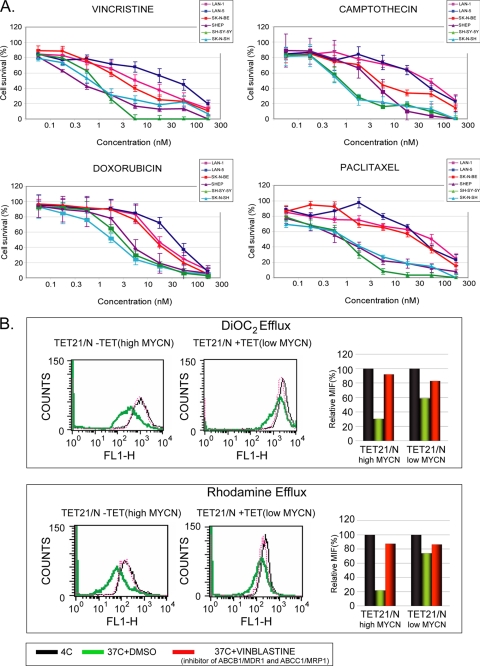FIGURE 6.
MYCN amplification/overexpression results in an increased IC50 of the different chemotherapeutic drugs in human neuroblastoma cells and affects cellular efflux activity in TET21/N. A, cell survival for the panel of chemotherapeutics shown in figures was evaluated in neuroblastoma cells with high levels (LAN-1, LAN-5, and SK-N-BE(2)-C) or low levels (SH-SY5Y, SK-N-SH, and SHEP) of MYCN. Each cell population was exposed to increasing concentrations of chemotherapeutic drug for 72 h. Cell viability was assessed by 3-(4,5-dimethylthiazol-2-yl)-2,5-diphenyltetrazolium bromide assay for each cell line and plotted as percentages of cells that survived as compared with cells cultured in drug-free medium. The results represent the means ± S.D. from four independent experiments. B, accumulation of DiOC2 and rhodamine 123 was evaluated in TET21/N before and after MYCN induction. The efflux activity of ABC transporters is temperature-sensitive. ABC transporters function optimally near 37 °C but are effectively inactive at 4 °C. Hence, the cells incubated with fluorescent substrates retain the dye and consequently have high fluorescence when incubated at 4 °C (black lines and bars). Conversely, cells incubated at 37 °C (green lines and bars) more readily efflux the dye and show reduced fluorescence. In the presence of vinblastine (red lines and bars), MDR1 and MRP1 are inactive, and the cells reduce dye efflux. The data were obtained measuring the fluorescence of these two dyes by flow cytometry. For each condition, the mean fluorescence intensity was calculated and plotted below.

